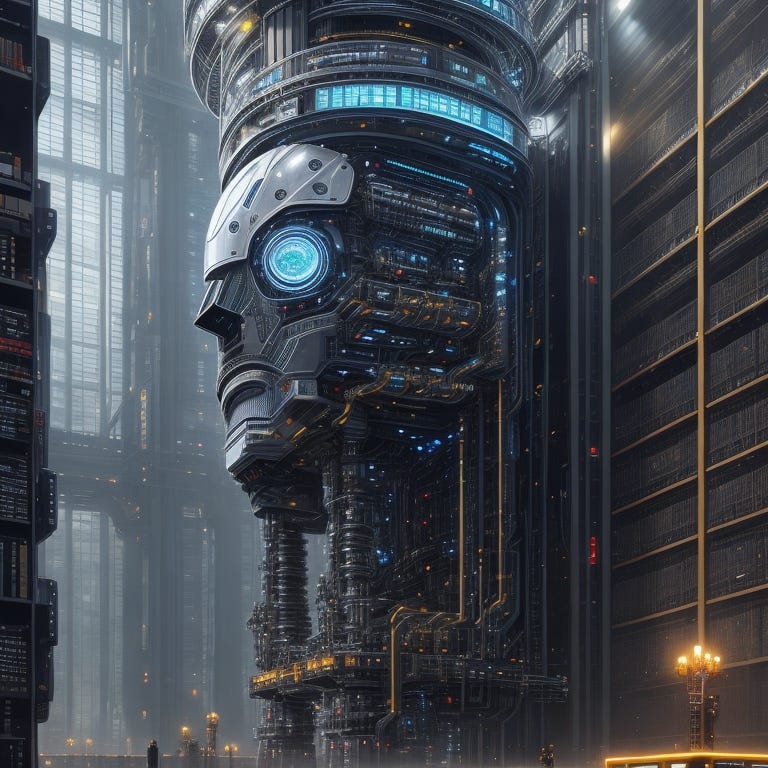Building career paths with AI
Using ChatGPT to generate basic Career Ladders helps you keep them up to date.
Note: This is the first of a series of articles on using AI on HR, including for content generation, data analysis and more.
1️⃣ Introduction
In the fast-paced world of HR, professionals are constantly challenged to develop and maintain accurate job descriptions and career ladders. The ever-evolving nature of the job market, coupled with the unique demands of each organization, makes it a formidable task. In addition, the traditional method of crafting these documents can be labor-intensive, repetitive, and time-consuming. However, the advent of artificial intelligence (AI) has ushered in a new era of innovation, making it easier than ever for busy HR professionals to build dynamic career ladders and job architectures. 🪜
2️⃣ Dynamic and Ever-Evolving Job Descriptions
One of the primary challenges HR professionals face is the dynamic nature of job descriptions and career ladders. The job market is constantly evolving, with new roles and skill requirements emerging as technology advances. Traditionally, creating and updating job descriptions manually was a time-consuming process that often resulted in inaccuracies and inefficiencies. With AI, this process becomes more adaptive and flexible.
AI systems can use adaptable prompts that are sequentially executed for different job positions. These prompts can be easily adjusted to reflect the specific needs of an organization and can incorporate real-time labor market data. This means that HR professionals can swiftly and accurately tailor job descriptions to match the ever-changing landscape of their industry. With AI, staying up to date and aligning job descriptions with current market demands becomes a breeze, allowing HR teams to keep their organization's career ladder relevant and agile.
3️⃣ Eliminating Repetitive and Meaningless Work
Another challenge faced by HR professionals is the repetitive and often mundane nature of crafting job descriptions and career ladders. These tasks can involve endless cycles of copying and pasting templates, filling in the same information for different roles, and ensuring consistency across multiple documents. The result is that HR professionals are often bogged down by administrative tasks, diverting their attention from more strategic HR activities.
AI can come to the rescue by automating these repetitive processes. Through the use of AI-powered algorithms, HR professionals can create a set of templates and prompts that are easily adaptable for various job positions. Once these templates are established, AI can generate initial drafts for different roles, saving time and reducing the burden of manual data entry. By automating these tasks, HR professionals can focus on more meaningful and strategic aspects of their work, such as talent acquisition, employee development, and organizational culture improvement.
4️⃣ AI-Powered Adaptive Prompts
AI-driven adaptive prompts are at the heart of this transformation. These prompts are designed to capture essential information and key details for job descriptions and career ladders. By using adaptable, pre-defined prompts, HR professionals can simply input the job title or role they wish to create a career ladder for. The AI system can then run the prompts sequentially, generating a starting draft that can be refined and customized further.
These adaptable prompts consider not only the specific requirements of the role but also the industry's best practices. For instance, if an HR professional needs to create a career ladder for a "Senior Software Developer," you can instruct the AI system to ask a series of relevant questions, such as the required qualifications, responsibilities, and career progression criteria. These prompts ensure that the generated draft is comprehensive and up to industry standards.
In conclusion, AI is transforming the way HR professionals build dynamic career ladders and job architectures. With the use of adaptable prompts, AI can automate the creation of job descriptions, ensuring they remain up-to-date and industry-relevant. By eliminating repetitive and time-consuming work, HR professionals can focus on more strategic HR activities. The future of HR is increasingly AI-driven, offering more efficiency and accuracy in crafting job descriptions and career ladders, ultimately benefiting both HR professionals and the organizations they serve.
5️⃣ Let’s put this into action
In a few minutes, I created and tested the prompt below on ChatGPT 3.5, with good results for various roles. I even used ChatGPT to help me refine the initial prompt to make it produce the same valuable results, in a more efficient way.
Of course, results may vary and the expectation is that you will still need to review the output, and possibly adjust the prompt to the unique needs of your organization and your roles. But it still beats starting with a blank page.
Here’s my prompt, feel free to reuse, tweak, and customize it to your needs.
As a first step, I usually like to prime ChatGPT with some context and roleplaying instructions:
"I want you to act as a Senior HR Job Analysis Consultant.
We're going to be building the essential artifacts for a career ladder for a skills-based organization in the Software Development industry. Take a deep breath and please confirm that you understand the task, so I can provide the instructions for the positions to generate content for."Once you’ve got a confirmation from ChatGPT, you can run the actual prompt:
"As a first step, I want you to summarize the core 10 skills most frequently demanded for a Scrum Master role in this industry. Then, I want you to craft 2 paragraphs that describe the core responsibilities of the position.
Then, I want you to suggest 5 similar job titles frequently used in the industry. Next, I want you to help me identify 3 tiers that serve as labels for the increasing experience level for this role, and for each tier, please include behavioral descriptors.
For each tier, I want you to define 2 adjacent roles, and the skill gaps that would need to be covered to move from one to the other.
For each tier, I want you to build a Candidate Evaluation Rubric to be used in the hiring process, including the questions a recruiter could ask to assess each one of the evaluation categories.
Once you have done that, I would like you to present the information we discussed in the following format:
Job Title
Job Responsibilities
Job Skills
Similar Job Titles
Tiers of Experience
Adjacent Roles and Skill Gaps
Candidate Evaluation Rubric
Once you have done that, I would like you to present the information we discussed in a table, using the following format: Job Title | Years of Experience | Behavioral Descriptors | Evaluation Criteria | Adjacent Roles."And here are the kind of results that I got, for a Scrum Master position:
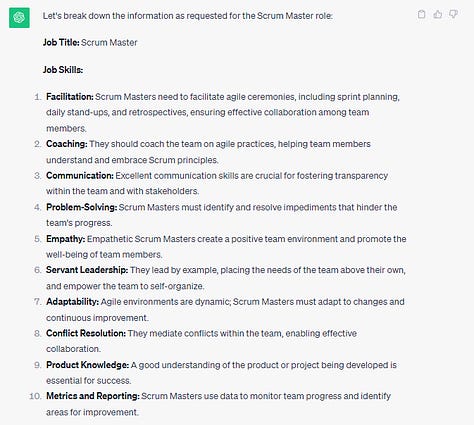
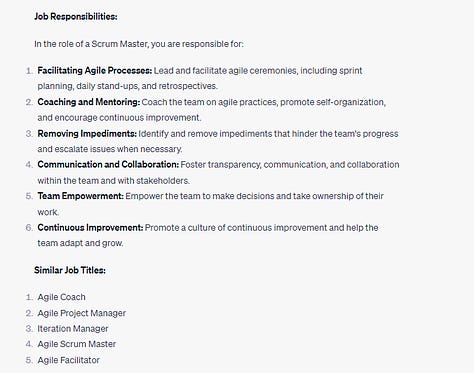
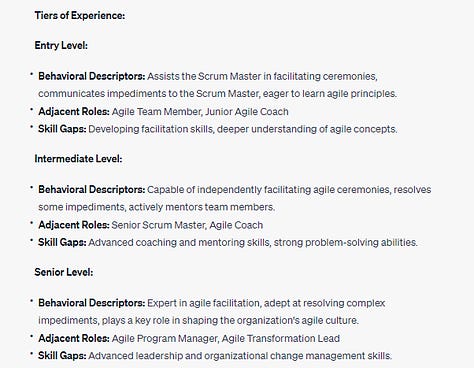
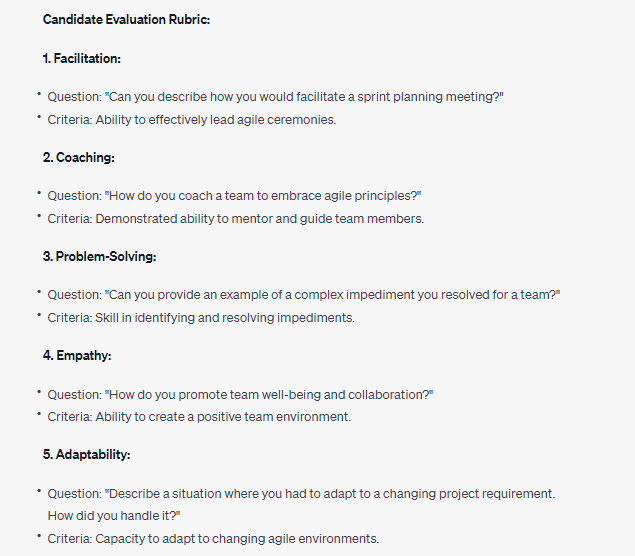
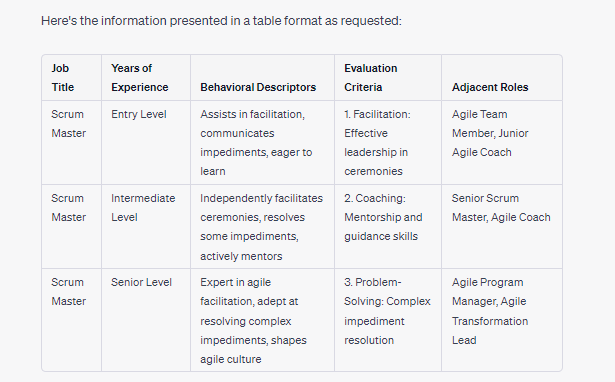
7️⃣ Working with the results
Is it perfect? No, it requires some refinement, and the savvy eye of an HR professional to ensure the results are something we’d be proud to put in front of our candidates and employees.
Is it 100% complete? It depends on your needs. You can make it more complete to your needs, for example by adding instructions like: “Create a job posting based on the Job Description”, or “Analyze the tone of the Job Description/Job Posting and provide a report on the tone“. You could also train ChatGPT on the tone of your organization so that it uses some of the same language. Or, if you want to use the output programmatically, you can ask it to output the content using JSON format, so it’s easily readable by other software. The sky is the limit!
Is it useful as a starting point? Totally! It’s a time-saver that can help us do this job faster, especially as these kinds of features are added to more specialized tools like Role Mapper, Beamery, and many others, for automated generation and updates.
Let me know what you think about this in the comments!





